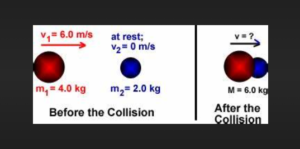Table of Contents
Introduction
The Centre of Mass of an object or a system of objects is a place defined relative to that object. The Centre of Mass is the average position of all pieces that are weighted according to their Masses in a system.
The vector quantity linear momentum is defined as the product of an object’s mass, m, and velocity, v. For short, the letter ‘p’ is utilised to denote it and is employed as momentum. Please keep in mind that the body’s momentum always follows its velocity vector. It’s a conserved quantity, meaning that a system’s total momentum remains constant.
HC Verma Solutions for Class 11 Physics-Chapter 9: Most Important Topics
- Centre of mass: The place at which the total mass of the body is supposed to be concentrated is called the centre of mass.
- Linear Conservation of Momentum: is a general physics law that asserts that in an isolated collection of objects, the momentum that characterises motion never changes; that is, the total momentum of a system remains constant.
- Angular Momentum Conservation: In the absence of an external torque, the system’s total angular momentum remains constant.
- Collision: also known as impact, is the quick, powerful coming together of two bodies in direct contact.
- Collision with elastic properties:
- Impulse and Impulsive Force: The product of a large force operating over a short period of time and the time interval during which the impulsive force is applied is known as the impulsive force.

Why is it necessary for students to consult the HC Verma books and solutions?
HC Verma is widely regarded as the inventor of Class 12 physics. It contains problems and solutions for various degrees of difficulty. To learn the different important principles in-depth and with a suitable basis, one needs to refer to HC Verma. The HC Verma books make sure that students are taught all of the fundamental topics while also guiding them. Vedantu assists you in obtaining the best study material, which includes all of the major themes and is organised by the best teachers. You can improve your grades by practising on the worksheet supplied on the site, and you can receive one-on-one help to clear out any doubts you may have.
Also read: HC Verma Solutions Class 11 Chapter 11 Gravitation
FAQs
Q: What is a particle system’s centre of mass?
Ans: A simple explanation of the centre of mass with a diagram is provided in the section “Centre of Mass.” The centre of mass in a two-particle system divides the line connecting the two particles internally in the inverse ratio of their masses.
Q: How do you calculate the aggregate mass of two particles?
Ans: In a two-particle system, the centre of mass divides the internal line connecting the two particles in the inverse ratio of their masses. If we know the centres of mass of the system’s parts and their masses, we can find the combined centre of mass in a system with a larger number of particles.
Q: In an inelastic collision, what happens to momentum?
Ans: When two objects moving in opposing directions with the same momentum (p=mv) collide in a completely inelastic collision, they cling together. The momentum will be 0 because it is conserved. The kinetic energy (of motion) is largely transferred to heat because they are not moving after the contact.






